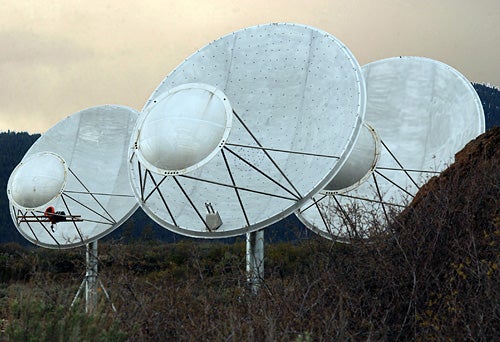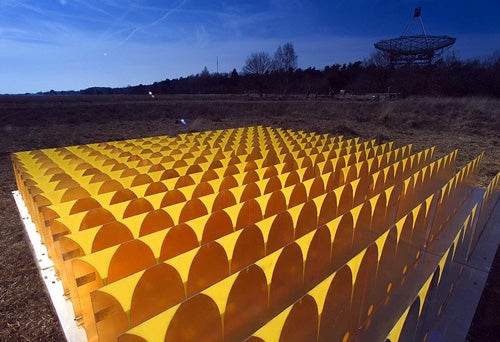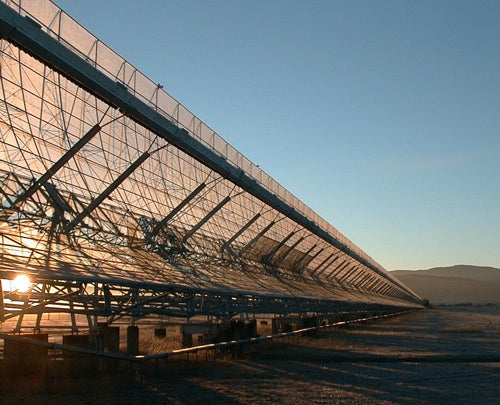The SKA will follow on the heels of LOFAR, PAST, and MWA — three radio arrays being developed and tested — with improved sensitivity. The main science goal behind the SKA — to search for neutral hydrogen’s 21-centimeter line, pinning down when the universe reionized — will need the sensitivity.
The SKA will operate over a frequency range of 100MHz to 25GHz, enabling astronomers to make a variety of deep observations.
The SKA will have — as its name implies — a square kilometer collecting area, distributed among 30 to 100 “stations.” Each station will be between 30 and 300 meters in diameter. (For comparison, the Arecibo Telescope in Puerto Rico has a diameter of 305 meters.)
The SKA will have stations spiraling away from a dense core. Twenty percent of the collecting area must be within a 1 kilometer-diameter circle, 50 percent within 5 km, and 75 percent within 150 km. The outer edge of the entire collecting area must be at least 3,000 km away.
SKA scientists need to find a location to accommodate such a large configuration, among other things. Four countries are vying to host the SKA: Argentina, Australia, China, and South Africa. The SKA timeline calls for a decision in 2006.
The consortium looks for, most importantly, a site that is radio quiet (free from television, radio, mobile phone, radar, and similar transmissions). Other major factors are the atmospheric conditions — the site must have a dry climate — and land must be inexpensive. The operating-cost goal is $1,000 per square meter, which is a factor of 10 less than current technology costs.
Each competing location must measure the radio interference for at least one year before a site is chosen.
Location isn’t everything
Once the location is decided, SKA scientists must choose a design. One concept is 4,400 small, steerable parabolic dishes, 12m each in diameter. Another is aperture arrays. These have no moving parts but are able to observe in multiple directions simultaneously.
Cylindrical reflectors need to rotate only along one axis — lengthwise — compared to dishes, which must rotate along two axes to focus. The electronics for cylindrical reflectors, however, are more complicated than for parabolic dishes. Another possibility is a giant spherical reflector, like Arecibo, with the receiver system suspended from cables. Such a dish would have to be built into the location site.
The design chosen must be able to view the sky in multiple directions at once. The final telescope design will be decided in 2008 and will likely incorporate features from more than one concept to satisfy the science goals.
So, what are the science goals?
The main purpose of the SKA is to study large-scale structure and galaxy evolution. SKA will detect neutral hydrogen at high redshifts and find the universe’s Equation of State, which gives astronomers a relation between dark energy and cosmic time.
Another major goal is to probe the cosmic Dark Ages to determine the time of the reionization epoch. This will give astronomers details about black-hole, star, and galaxy formation, and how these structures influenced their environments.
The SKA also should help our understanding of gravity by studying the timing of pulsar binaries. Astronomers expect to find thousands of pulsars, including some in orbit around black holes.
Astronomers want to use the SKA to see if there is any connection between early structure formation and the formation of magnetic fields. They’d like to learn how and when magnetic fields formed.
Not all the key science projects relate to cosmology — the fifth science goal is to search for terrestrial planets. The SKA will have the resolution to observe protoplanetary disks, traces of amino acids and other complex biomolecules, and to detect leakage radiation from radio transmitters, if another civilization is transmitting.
The SKA Telescope, with 100 times the sensitivity of current radio arrays, may lead to phenomenal discoveries.













